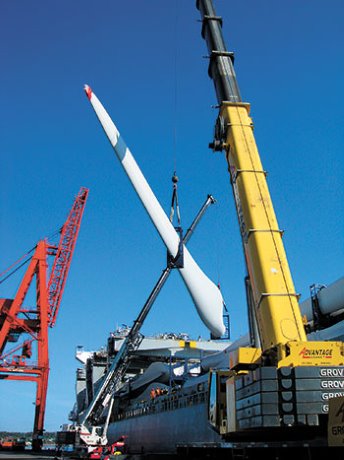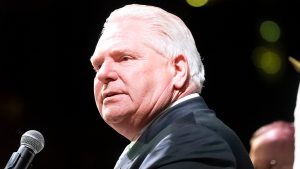A small army of cranes is at Vancouver Island’s Cape Scott to install massive turbines for a wind farm.
A small army of cranes is at Vancouver Island's Cape Scott to install massive turbines for a wind farm.
The 55 Vesta V100 1.8 MW turbines, produced by the world’s largest turbine manufacturer based in Denmark, are being erected for International Power’s Cape Scott Wind Farm.
“The best description that I have heard is that North Island is the best place to have a wind farm, but it is the worst place to build a wind farm,” said Steve Tidder, co-owner of Advantage Crane.
Advantage crews have been instrumental in off-loading and loading the huge turbine components from ships to lay-down areas in Nanaimo and Port Hardy.
The company is also doing site prep at the Knob Hill 99 MW wind farm.
The heavy lifting on site will be done by Eagle West’s largest cranes, an LG1550 (one of three in Canada) and the LR1400, which each break down into 15 trunk loads for transport to site.
“There will be eight support cranes on site,” said Tyler Hannah, one of several Eagle West Wind Energy division project managers working on the erection, wiring and mechanical completion.
Transporting 55 Vesta turbines, cranes and support equipment to the remote area has been an exercise in logistics and co-ordination.
“The nightmare has been the logistics, the flow and the schedule,” Tidder said.
The supply chain stretches from Nanaimo’s Duke Point to a remote wilderness area, where crews are installing footings.
“You don’t want to be the cause of a delay. You want to make sure you are holding up your end,” he said.
All the cranes used at the North Island had to be trucked into Port Hardy and the plateau area.
Rebar and building materials used for footings construction also had to be trucked in.
The turbine arrived in pieces by a series of ships from China and Vietnam into the Port of Nanaimo last year.
Each turbine consists of three 50-metre blades, a nacelle housing the gears and the tower sections.
Assembled, the units measure 75 metres tall.
When off-loading the long blades, two Advantage crane operators had to work in synchronized harmony, said port sales manager Doug Peterson.
A large Amix Group crane on a barge was used to lift heavier nacelle pieces out of the vessel’s hold and onto waiting trucks.
The turbine lay-down area at Duke Point had to be reinforced to sustain the weight of the units
The exercise was a challenge for the port, Peterson said, as it normally handles pulp and lumber.
“But, it went seamlessly,” he said.
The units have been making their way to Port Hardy to a second lay-down area.
Advantage has been using a series of cranes from a 100-ton truck crane to 275-ton hydraulic cranes loading out from Duke Point to Port Hardy’s second staging area, where components await reloading for site transport.
Tidder said two sets of trucks had to be used.
Highway haul units are used between Nanaimo and Port Hardy, but in Port Hardy, the highway trucks are swapped over for off-highway units able to tackle the steeper plateau grade.
Transport ministry district manager for Vancouver Island, Renée Mounteney, said highway trucks are being restricted to night operations between Nanaimo and Port Hardy, and no hauling is permitted on Saturday.
A traffic plan is being assembled for travel on the Port Hardy to Holberg public road.
Port Hardy Mayor Bev Parnham, who attended a meeting with transport officials and project representatives, said they are building turnouts so there won’t be traffic delays.
It will take about 10 trucks to bring each turbine to the site.
Parnham said the town is prospering as a result of the development.
Hotels are busy and local contractors, such as Port Hardy Bulldozing, are working on the project.
Access to the site has required the construction of a new 33 kilometre access road from Holberg, a former military base and logging camp.
Julie Vitek, vice-president corporate communications for project majority shareholder GDF Suez said roadwork is underway.
It involves building about 20 bridges required to sustain the heavyweight vehicles that are trucking in equipment and the turbines.
At the site, about 20 footings were part of the first phase.
AMEC Black & McDonald are overseeing the engineering, procurement and construction.
International Power is 70 per cent owned by GDF Suez and has a 20-year contract with BC Hydro.
International Power has purchased the first phase of the Cape Scott project from Sea Breeze Power Corporation.












Recent Comments
comments for this post are closed